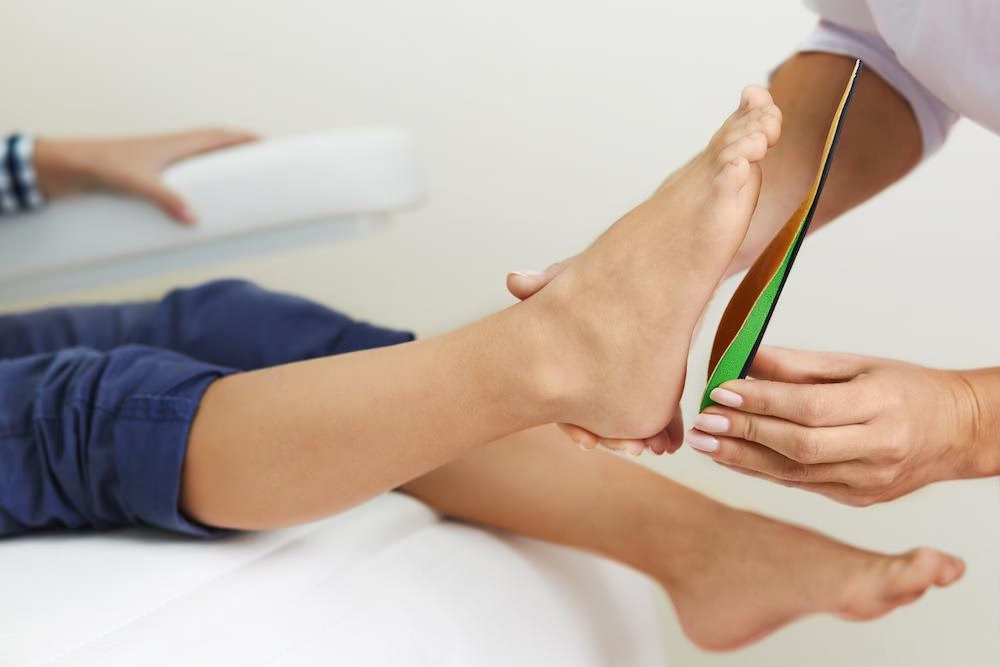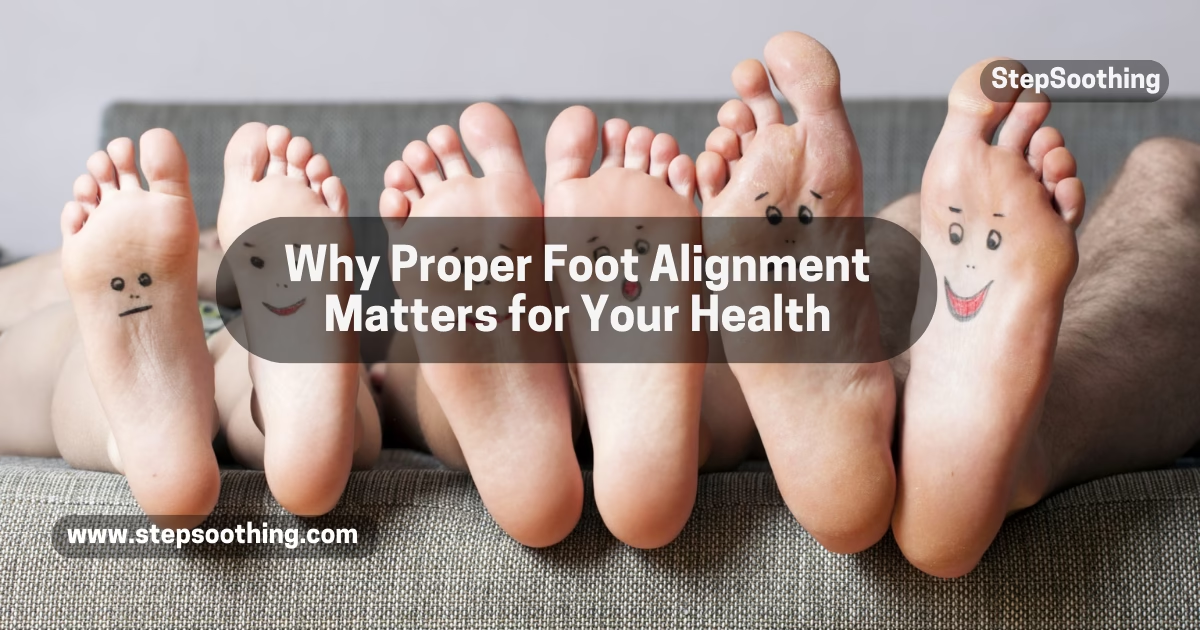A correct foot alignment is essential for athletes as it impacts their motion, balance, and injury prevention. Whether you walk, run, cut, or jump, your feet dictate how force travels through your leg joints, including the ankle, knee, and hip. Misalignment can create tension in these areas, leading to back problems and even chronic injuries. Marathoners running fifteen miles need stable foot positioning to prevent body breakdown over an entire season.
Poor foot functioning can result in nagging muscle strains, knee tendonitis, and ankle sprains, all of which can stem from a foot deviation. If your foot abnormally rolls inward or struggles with dorsiflexion, your body compensates by placing extra stress on the shin splints, plantar fascia, and calf muscles. This unnatural adjustment may cause a chain reaction, resulting in back injuries that require intervention to restore muscle length and joint motion. Common foot problems like plantar fasciitis and overpronation can also contribute to improper foot mechanics.

Importance of Proper Foot Alignment
Understanding Dorsiflexion and Joint Motion
Dorsiflexion is the ankle’s bend that allows the foot up movement during walking or running. A sufficient dorsiflexion of 10º to 15º is required to walk correctly and ensure the foot rolls properly when it hits the ground. When the foot pronates or supinates, it affects how the calf muscles, joint motion, and foot functions work together.
A foot needs to absorb shock efficiently; otherwise, malalignment can contribute to stress in the leg, knee, and hip. The natural rolling-in motion (pronation) should be about 5-6º, while the foot supinates to push off with a strong, rigid base. If the foot overpronates, it keeps rolling instead of supinating, which can make the foot loose and cause excessive strain and fatigue in the muscles. Foot misalignment can also lead to knee pain, increasing discomfort and limiting mobility.
Related Articles : Enhanced Comfort and Shock Absorption
The Importance of Correct Posture
How Proper Posture Reduces Pain and Prevents Injury
Maintaining good posture starts with proper foot alignment, which influences the entire spine, head, neck, shoulders, hips, and knees. Whether standing or sitting, the body should form a straight line from the ears to the ankles. A 90-degree knee angle when seated ensures balanced weight distribution, reducing stress on ligaments, joints, and muscles.
A misaligned posture leads to decreased mobility, making movement harder as tight muscles limit flexibility. Proper posture alignment stabilizes the body, allowing individuals to adapt to uneven or sloped terrain. A Pedorthist can assess how feet, ankles, bones, and joints contribute to overall movement and provide corrective measures if walking or standing posture is affected. Using the right insoles can provide extra support learn how insoles help alleviate plantar fasciitis.
What is Supination?
Supination and Its Impact on the Body
Supination is the rotation outwards of the foot, where the heel rotates outwards, shifting weight to the outside of the foot. This occurs when a person stands, walks, or runs, causing the lower leg to adjust. Excessive supination can lead to ankle sprains, shin splints, calluses, and pain in the heels or balls of the feet.
A supinated foot lacks shock absorption, meaning that the bottom of the foot endures excessive pressure. This pressure affects the knees, hips, and lower back, increasing the risk of chronic discomfort. The right foot orthotic with extra cushioning in the sole can help realign weight distribution and improve overall stability.
Related Articles : Improved Foot and Ankle Alignment
What is Pronation?
The Effects of Pronation on Foot Health
Pronation is the rolling inwards of the foot, the opposite of supination. This natural movement helps with shock absorption, but excessive foot pronation can lead to plantar fasciitis, bunions, and knee pain. When the foot pronates excessively, the leg rotates inward, putting extra strain on the knee, hip, and lower back structures.
This misalignment forces the upper leg to rotate, further stressing the knee and hip joints. Over time, it may lead to chronic lower back pain, affecting daily movements. Recognizing the difference between pronation and supination can help in selecting the proper footwear or orthotics to prevent these issues.

Foot Posture Benefits When Wearing Orthotics
How Orthotics Improve Foot Position and Prevent Injuries
Poor foot posture can contribute to low back pain and other function abnormalities. Research shows that 18% of the general population suffers from low back pain, with a significant financial impact on healthcare costs and lost productivity. Misalignment in the foot position can cause imbalances in pelvic alignment, affecting the erector spine and gluteal muscles during walking and running.
Using orthotics helps control excessive foot pronation, particularly in the stance phase of gait, where the calcaneus everts, and the talus adducts. These movements impact the knee joint, increasing the risk of patellofemoral pain syndrome (PFPS). Wearing properly fitted orthotics reduces stress on the lumbo-pelvic region, preventing chronic discomfort. Foot care practices can further enhance overall mobility and prevent injuries.
Related Articles : Pain Free Feet Discover Relief Now
Characteristics to Consider When Looking for an Orthotic
Choosing the Right Orthotic for Your Needs
Not all orthotic devices are the same. The right foot orthoses must match an individual’s foot structure and provide arch support without causing spilling, pinching, or discomfort. A custom orthotic is often the best solution, as it offers targeted offloading and support for key pressure points.
The materials used in orthotics are selected based on weight reduction and comfort. Custom orthotics typically range from $400 to $650, but over-the-counter shoe inserts offer a more affordable alternative. A Canadian Certified Pedorthist can provide recommendations based on an individual’s foot condition and activity level.
Improving Foot Posture by Seeing a Pedorthist
Expert Guidance for Long-Term Foot Health
A Pedorthist can assess foot posture issues and recommend treatment modalities such as custom orthotics, footwear modifications, and strengthening exercises. The right footwear is an important part of a treatment plan, as shoes with the wrong features can worsen conditions.
Temporary solutions like taping, bracing, or external shoe modifications help alleviate discomfort in the acute phases of injury. Long-term interventions, such as muscle conditioning and stretching, ensure proper foot control and reduce the likelihood of re-injury.
Related Articles : Life-changing Arch Support for Flat Feet
Why Proper Support and Alignment is Important for Your Feet
The Role of Foot Support in Overall Health
Proper support and alignment are crucial for maintaining foot health and preventing long-term discomfort. The feet are the foundation of the body, just like a building’s foundation keeps it stable. Without proper foot support, stress can spread to the ankles, knees, hips, and back, leading to widespread pain.
Using custom-fit orthotics helps evenly distribute body weight, reducing excess pressure on the feet. A well-designed orthotic device ensures step-by-step comfort, improving posture and mobility while preventing injuries. Making foot care a daily priority keeps your body functioning at its best, allowing for pain-free movement in everyday activities and sports.
People Also Asked
Why is proper Foot Care Important?
Proper foot care is essential for maintaining healthy movement, balance, and injury prevention. Our feet absorb shock with every step, and neglecting them can lead to chronic pain, foot deformities, and mobility issues. Issues like plantar fasciitis, bunions, and tendonitis often stem from poor foot health. Regular foot hygiene, proper footwear, and strengthening exercises help prevent discomfort and long-term complications.
Why is Foot Placement Important?
The way your foot is placed when you walk, run, or stand directly affects your posture, stability, and joint health. Poor foot placement can cause misalignment in the ankles, knees, hips, and spine, leading to stress, muscle imbalances, and injuries. Athletes, in particular, rely on correct foot placement to improve performance, absorb impact, and prevent overuse injuries like shin splints or knee tendonitis.
What is the importance of toe alignment?
Toe alignment plays a critical role in foot mechanics, weight distribution, and balance. Misaligned toes, such as those caused by bunions or hammertoes, can result in pain, difficulty walking, and poor posture. Proper toe positioning ensures that pressure is evenly distributed across the foot, preventing strain on muscles and joints. Wearing the right shoes and practicing toe exercises can help maintain healthy toe alignment and overall foot function.
Why is foot posture important?
Foot posture determines how your body weight is distributed, affecting your gait, joint health, and movement efficiency. Poor foot posture, such as fallen arches or excessive pronation, can lead to ankle, knee, hip, and lower back pain. Maintaining proper foot posture helps with shock absorption, reduces stress on the body, and prevents long-term musculoskeletal issues. Custom orthotics, strengthening exercises, and proper footwear can improve foot posture and overall body alignment.
What is the importance of foot alignment?
Foot alignment is crucial for stability, mobility, and injury prevention. When the foot is aligned correctly, it distributes force evenly, reducing the risk of ankle sprains, shin splints, and knee pain. Poor foot alignment can cause overpronation or supination, leading to joint stress, muscle fatigue, and poor movement efficiency. Proper foot alignment enhances walking, running, and jumping mechanics, ensuring a pain-free and functional movement pattern.
Related Articles : Are you concerned about your foot health? Visit Step Soothing to explore essential information foot health, Learn about Life-changing Arch Support for Flat Feet, Enhanced Comfort and Shock Absorption, Improved Foot and Ankle Alignment, Pain Relief, and more!



